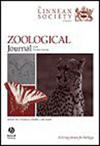欧洲和亚洲双翅目蝶蝇种重访(双翅目:手蛾科:蝶蝇科):形态和分子的见解
IF 3
2区 生物学
Q1 ZOOLOGY
引用次数: 0
摘要
蝶翅虫是一种适应寒冷的双翅目:手蛾科属,栖息于北半球和东非的寒冷淡水中。全球变暖和冰川萎缩正威胁着它们的生存。在这项工作中,我们旨在为比利牛斯、阿尔卑斯山和喀喇昆仑山脉的Diamesa物种的分类差距和系统发育提供新的见解,以更好地了解其定植过程,并更准确地统计濒危物种的数量。形态学鉴定和DNA条形码(COI)之间的不一致性突出,表明需要其他方法结合来估计遗传距离。我们利用两个核基因(CADI和cadv)和三个线粒体基因(COI、COII和16S)的分子数据重建了古北猿的系统发育。我们强调:(1)steinboecki组与其他Diamesa物种的共同祖先具有较强的冷适应能力;(ii)欧洲和亚洲的steinboecki群在中新世(~15万年)分离;(3)阿尔卑斯山物种的主要多样化发生在上新世—更新世,主要发生在冰期和间冰期的交替时期。这证实了物种进化和气候变化之间的密切关系。本文章由计算机程序翻译,如有差异,请以英文原文为准。
Revisiting European and Asian Diamesa species (Diptera: Chironomidae: Diamesinae): morphological and molecular insights
Diamesa is a cold-adapted genus of Diptera: Chironomidae colonizing cold freshwaters of the Northern Hemisphere and East Africa. Global warming and glacier shrinkage are threatening their survival. In this work, we aimed to provide new insights into taxonomical gaps and phylogeny of Diamesa species from the Pyrenees, Alps, and Karakorum mountains to understand the colonization processes better and have a more accurate count of the number of endangered species. An incongruence between morphological identification and DNA barcoding (COI) was highlighted, suggesting the need for other approaches combined to estimate genetic distance. We reconstructed the phylogeny of the Palaearctic, using molecular data from two nuclear (CADI and CADIV) and three mitochondrial (COI and COII and 16S) genes. We emphasized that: (i) the Diamesa steinboecki group shares with the common ancestor of the other Diamesa species a strong cold adaptation; (ii) the European and Asian species belonging to the steinboecki group separated from each other during the Miocene (~15 Mya); and (iii) the major diversification of species in the Alps occurred during the Plio-Pleistocene epochs, mainly during the alternation of glacial and interglacial periods. This confirms the strong relationship between species evolution and climate change.
求助全文
通过发布文献求助,成功后即可免费获取论文全文。
去求助
来源期刊
CiteScore
6.50
自引率
10.70%
发文量
116
审稿时长
6-12 weeks
期刊介绍:
The Zoological Journal of the Linnean Society publishes papers on systematic and evolutionary zoology and comparative, functional and other studies where relevant to these areas. Studies of extinct as well as living animals are included. Reviews are also published; these may be invited by the Editorial Board, but uninvited reviews may also be considered. The Zoological Journal also has a wide circulation amongst zoologists and although narrowly specialized papers are not excluded, potential authors should bear that readership in mind.

 求助内容:
求助内容: 应助结果提醒方式:
应助结果提醒方式:


